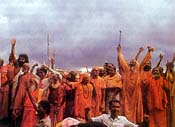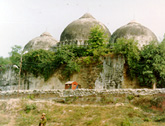Commentary/Vir Sanghvi
Does Vajpayee have the guts to condemn the VHP?
 Last week, the Vishwa Hindu Parishad took a party of journalists to Mathura. The VHP wished to draw the media's attention to a
mosque located near a Krishna temple in the town. It claimed that
the location and management of the mosque made it difficult for
Krishna bhakts to enter their temple.
Last week, the Vishwa Hindu Parishad took a party of journalists to Mathura. The VHP wished to draw the media's attention to a
mosque located near a Krishna temple in the town. It claimed that
the location and management of the mosque made it difficult for
Krishna bhakts to enter their temple.
The Mathura issue has been raised in tandem with its traditional
counterpart: The Kashi problem. In this case, the VHP claims that
a fully functioning mosque poses enormous problems for a nearby
temple mainly because it is situated on land that is really part
of the temple complex.
Property disputes are a regular feature of Indian life. And though
real estate squabbles of a religious nature are slightly more
complex, they are not particularly different. Perhaps the management
of the Mathura mosque does obstruct the Krishna bhakts.
And perhaps the Kashi temple does own a part of the land on which
the mosque is located.
It is hard to decide what the truth is without hearing both sides
of the story. Certainly, the Mathura case is particularly complex.
In the early 1970s the temple and the mosque came to an understanding
about which area belonged to whom. This arrangement endured till
the mid-1980s when a riot broke out but a new compromise was reached
and peace restored.
By then however, the dispute had acquired a new and more worrying
dimension. The way the VHP saw it, the problem was not one of
access or ownership. It was one of faith. The reason the Mathura
temple and the surrounding area were important was because it
was in this area that Lord Krishna was born.
Of course, there was no historical evidence -- or no convincing
evidence at any rate -- to prove that this was the birthplace.
But a large number of Indians believed it to be so. In matters
of faith, historical evidence is not important: Belief is enough.
If all of this sounds familiar, then you will not be surprised
by the name that the VHP uses when it wants to refer to the disputed
area.
It calls it Krishnajanmasthan.
 Few disputes can have divided India as completely and as unnecessarily
as the fuss over the Ram Janambhoomi. The essential ingredients of
the Mathura problem are the same as they were in Ayodhya. The VHP,
a mosque, a temple, the claim to be the birthplace of a Hindu
god and a complete disregard of historical accuracy in the name
of faith. And the solution that is proposed is exactly the same:
Shift the mosque.
Few disputes can have divided India as completely and as unnecessarily
as the fuss over the Ram Janambhoomi. The essential ingredients of
the Mathura problem are the same as they were in Ayodhya. The VHP,
a mosque, a temple, the claim to be the birthplace of a Hindu
god and a complete disregard of historical accuracy in the name
of faith. And the solution that is proposed is exactly the same:
Shift the mosque.
When it came to the Ram Janambhoomi, many of us took the line that
even if Ram had not been born on the spot, even if a temple had
not been destroyed to build the mosque, it was in the interests
of the Muslim community to enter into negotiations and to consider
some kind of compromise.
We argued that the Babri Masjid was not worth fighting over and
that by refusing to enter into some kind of arrangement, the Muslim
leadership risked turning the mosque into a symbol of minority
appeasement and the Hindu backlash.
|





 Last week, the Vishwa Hindu Parishad took a party of journalists to Mathura. The VHP wished to draw the media's attention to a
mosque located near a Krishna temple in the town. It claimed that
the location and management of the mosque made it difficult for
Krishna bhakts to enter their temple.
Last week, the Vishwa Hindu Parishad took a party of journalists to Mathura. The VHP wished to draw the media's attention to a
mosque located near a Krishna temple in the town. It claimed that
the location and management of the mosque made it difficult for
Krishna bhakts to enter their temple.
 Few disputes can have divided India as completely and as unnecessarily
as the fuss over the Ram Janambhoomi. The essential ingredients of
the Mathura problem are the same as they were in Ayodhya. The VHP,
a mosque, a temple, the claim to be the birthplace of a Hindu
god and a complete disregard of historical accuracy in the name
of faith. And the solution that is proposed is exactly the same:
Shift the mosque.
Few disputes can have divided India as completely and as unnecessarily
as the fuss over the Ram Janambhoomi. The essential ingredients of
the Mathura problem are the same as they were in Ayodhya. The VHP,
a mosque, a temple, the claim to be the birthplace of a Hindu
god and a complete disregard of historical accuracy in the name
of faith. And the solution that is proposed is exactly the same:
Shift the mosque.